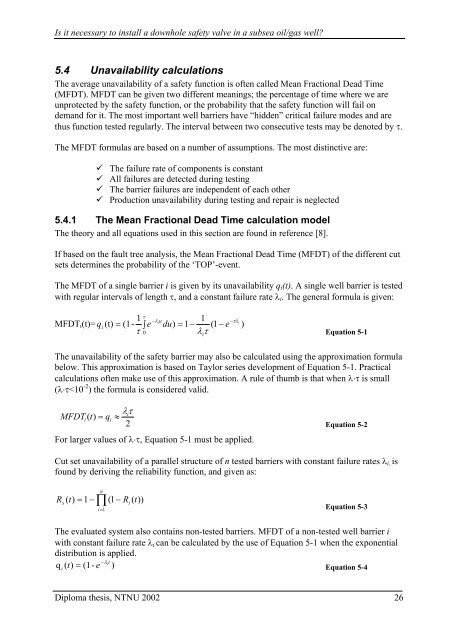Is it necessary to install a downhole safety valve in a subsea ... - NTNU
Is it necessary to install a downhole safety valve in a subsea ... - NTNU
Is it necessary to install a downhole safety valve in a subsea ... - NTNU
Create successful ePaper yourself
Turn your PDF publications into a flip-book with our unique Google optimized e-Paper software.
<strong>Is</strong> <strong>it</strong> <strong>necessary</strong> <strong>to</strong> <strong><strong>in</strong>stall</strong> a <strong>downhole</strong> <strong>safety</strong> <strong>valve</strong> <strong>in</strong> a <strong>subsea</strong> oil/gas well?<br />
5.4 Unavailabil<strong>it</strong>y calculations<br />
The average unavailabil<strong>it</strong>y of a <strong>safety</strong> function is often called Mean Fractional Dead Time<br />
(MFDT). MFDT can be given two different mean<strong>in</strong>gs; the percentage of time where we are<br />
unprotected by the <strong>safety</strong> function, or the probabil<strong>it</strong>y that the <strong>safety</strong> function will fail on<br />
demand for <strong>it</strong>. The most important well barriers have “hidden” cr<strong>it</strong>ical failure modes and are<br />
thus function tested regularly. The <strong>in</strong>terval between two consecutive tests may be denoted by τ.<br />
The MFDT formulas are based on a number of assumptions. The most dist<strong>in</strong>ctive are:<br />
The failure rate of components is constant<br />
All failures are detected dur<strong>in</strong>g test<strong>in</strong>g<br />
The barrier failures are <strong>in</strong>dependent of each other<br />
Production unavailabil<strong>it</strong>y dur<strong>in</strong>g test<strong>in</strong>g and repair is neglected<br />
5.4.1 The Mean Fractional Dead Time calculation model<br />
The theory and all equations used <strong>in</strong> this section are found <strong>in</strong> reference [8].<br />
If based on the fault tree analysis, the Mean Fractional Dead Time (MFDT) of the different cut<br />
sets determ<strong>in</strong>es the probabil<strong>it</strong>y of the ‘TOP’-event.<br />
The MFDT of a s<strong>in</strong>gle barrier i is given by <strong>it</strong>s unavailabil<strong>it</strong>y qi(t). A s<strong>in</strong>gle well barrier is tested<br />
w<strong>it</strong>h regular <strong>in</strong>tervals of length τ, and a constant failure rate λi. The general formula is given:<br />
1 τ<br />
−λ<br />
1<br />
iu −τλi<br />
MFDTi(t)= qi<br />
(t) = (1-<br />
∫ e du)<br />
= 1−<br />
( 1−<br />
e )<br />
τ 0<br />
λ τ<br />
i<br />
Equation 5-1<br />
The unavailabil<strong>it</strong>y of the <strong>safety</strong> barrier may also be calculated us<strong>in</strong>g the approximation formula<br />
below. This approximation is based on Taylor series development of Equation 5-1. Practical<br />
calculations often make use of this approximation. A rule of thumb is that when λ⋅τ is small<br />
(λ⋅τ


